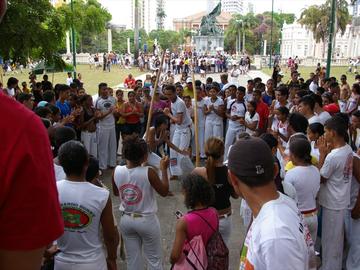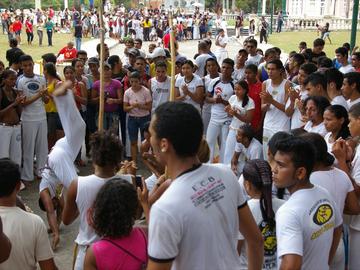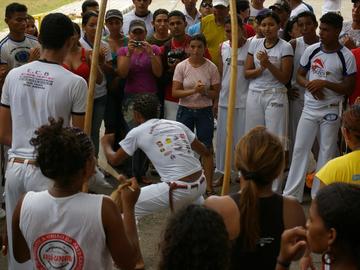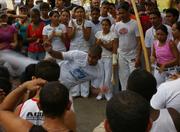Picture
More information on Capoeira at Praça da Republica in Belém

Description: Capoeira at Praça da Republica in Belém
The poultry may be an expression of what is most Brazilian terms of physical activity, since it is a struggle created in Brazil by slaves from Africa. This is so significant that capoeira abroad is known as "Brazilian martial art," or Brazilian martial art. As it is practiced in groups and accompanied by music which requires constant rate movements, many people confuse it with a game or some kind of dance, but as I said Pastinha: "Capoeira Angola is, above all, fighting, and violent struggle ".
The term poultry means "the forest is born after the deforestation," probably because it was practiced among these thickets, with the fighters close to the ground, to avoid detection by their masters. I must say that this time the poultry was a prohibited practice, because with the training their slaves how to self-defense, could mean trouble for those who considered their "owners." However, although prohibited, capoeira has always been practiced and taught.
In its original form, as already mentioned, capoeira was a fight move very slowly to the ground, very different from that capoeira is taught in gyms or play on the beaches of Rio de Janeiro: capoeira regional. It was in mid-twentieth century there was this break, resulting in the practice of Capoeira Angola in Bahia largely confined to ghettos. Capoeira regional acrobatic moves more, it is played on foot and has specific rules, a characteristic element of sport. Another important difference between these two types of poultry is how a member becomes master: capoeira regional, as the best practitioners are developing their skills, learn different strokes and thinking about these scams, they will be graded by a cord , where each color represents a stage in which the practitioner is classified, so it will acquire new cords to become a teacher. Capoeira Angola in the process is quite different: after many years of practice and dedication to master and poultry, the practitioner receives a master's handkerchief, which represents that the student is ready to master. Thus, in Capoeira Angola, the formation of the master depends exclusively on the will of the teacher teaching.
Another important feature is the music of capoeira. The music is always played by members of the wheel that turns, and is accompanied by a fundamental rule: members of the wheel always need to respond to the corner, also called the litany. The litanies are accompanied by the ringing of some instruments: tambourine, conga, caxixi, reco-reco and agogo.
Perhaps the most interesting are the litany of his lyrics that refer to the daily lives of slaves at the time of the capoeira roda, the gods of Candomblé (religion of African origin) and Catholicism, and the relationship between man and woman.
http://www.brasilescola.com/educacaofisica/capoeira.htm
More Photos of Picture




